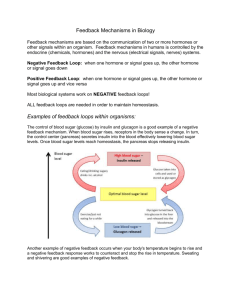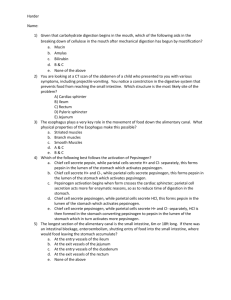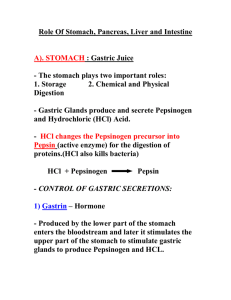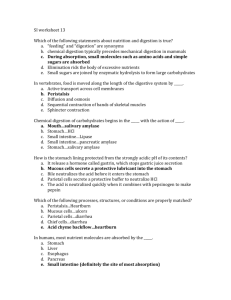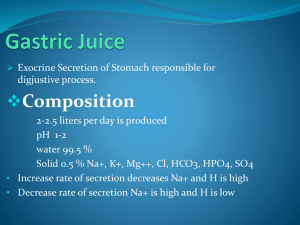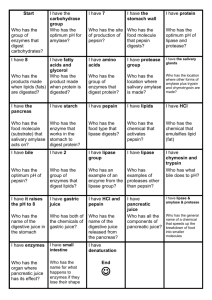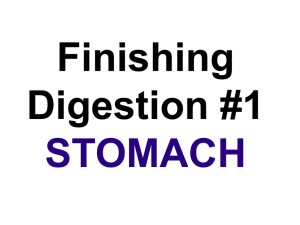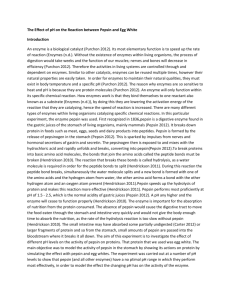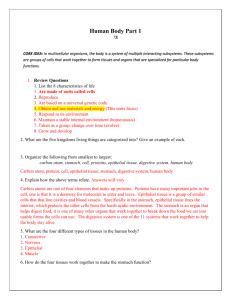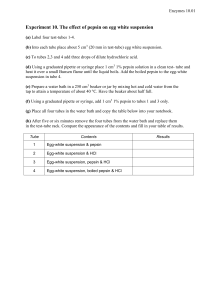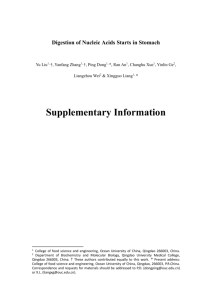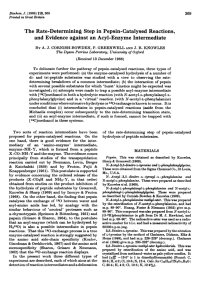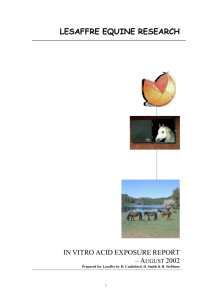Homeostasis Worksheet
advertisement
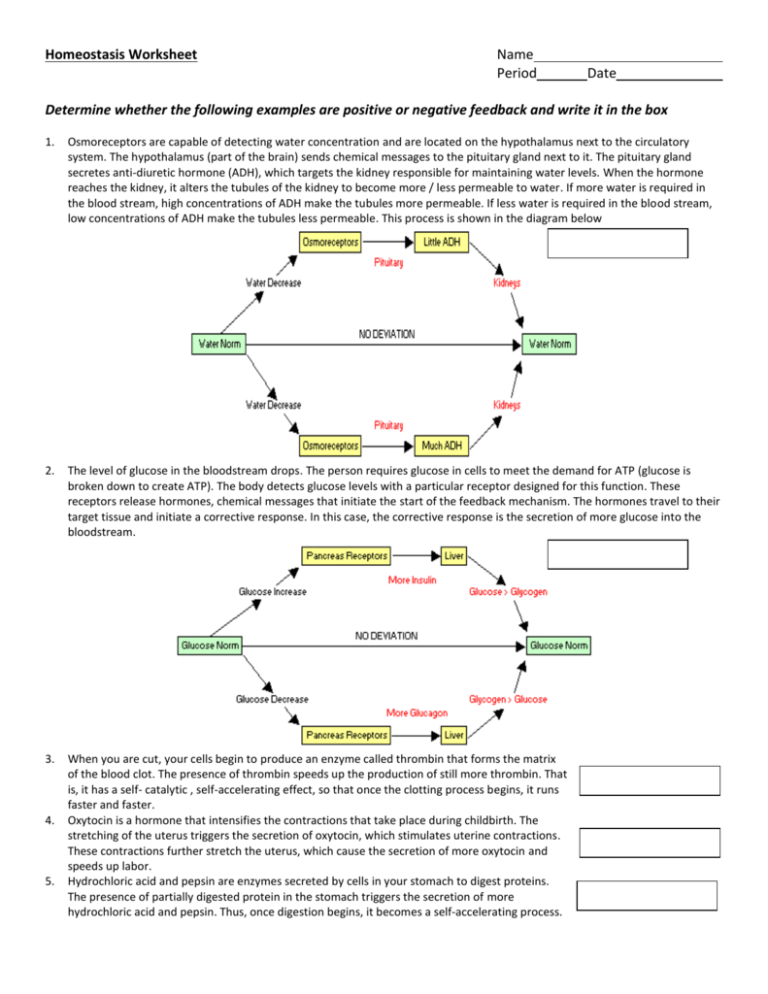
Homeostasis Worksheet Name Period Date Determine whether the following examples are positive or negative feedback and write it in the box 1. Osmoreceptors are capable of detecting water concentration and are located on the hypothalamus next to the circulatory system. The hypothalamus (part of the brain) sends chemical messages to the pituitary gland next to it. The pituitary gland secretes anti-diuretic hormone (ADH), which targets the kidney responsible for maintaining water levels. When the hormone reaches the kidney, it alters the tubules of the kidney to become more / less permeable to water. If more water is required in the blood stream, high concentrations of ADH make the tubules more permeable. If less water is required in the blood stream, low concentrations of ADH make the tubules less permeable. This process is shown in the diagram below 2. The level of glucose in the bloodstream drops. The person requires glucose in cells to meet the demand for ATP (glucose is broken down to create ATP). The body detects glucose levels with a particular receptor designed for this function. These receptors release hormones, chemical messages that initiate the start of the feedback mechanism. The hormones travel to their target tissue and initiate a corrective response. In this case, the corrective response is the secretion of more glucose into the bloodstream. 3. When you are cut, your cells begin to produce an enzyme called thrombin that forms the matrix of the blood clot. The presence of thrombin speeds up the production of still more thrombin. That is, it has a self- catalytic , self-accelerating effect, so that once the clotting process begins, it runs faster and faster. Oxytocin is a hormone that intensifies the contractions that take place during childbirth. The stretching of the uterus triggers the secretion of oxytocin, which stimulates uterine contractions. These contractions further stretch the uterus, which cause the secretion of more oxytocin and speeds up labor. Hydrochloric acid and pepsin are enzymes secreted by cells in your stomach to digest proteins. The presence of partially digested protein in the stomach triggers the secretion of more hydrochloric acid and pepsin. Thus, once digestion begins, it becomes a self-accelerating process. 4. 5. 6. 7. 8. 9. 10. 11. 12. 13. 14. 15. 16. 17. An increase in blood pressure is detected by receptors in the blood vessels that sense the resistance of blood flow against the vessel walls. The receptors relay a message to the brain, which in turn sends a message to the effectors, the heart and blood vessels. The heart rate decreases and blood vessels increase in diameter, which cause the blood pressure to fall back within the normal range or set point. Conversely, if blood pressure decreases, the receptors relay a message to the brain, which in turn causes the heart rate to increase, and the blood vessels to decrease in diameter. Some set points become "reset" under certain conditions. For instance, during exercise, the blood pressure normally increases. This increase is not abnormal; it is the body's response to the increased demand of oxygen by muscle tissues. When the muscles require more oxygen, the body responds by increasing the blood flow to muscle tissues, thereby increasing blood pressure. This resetting of the normal homeostatic set point is required to meet the increased demand of oxygen by muscles. When the body is deprived of food, the set point of the metabolic rate can become reset to a lower-than-normal value. This means your body digests food slower and gets more energy from the food. This lowering of the metabolic rate is the body's attempt to stave off starvation and keep the body functioning properly at a slower rate. Many people who periodically deprive themselves of food in attempts to lose weight find that after the initial weight loss it becomes increasingly difficult to lose more pounds. This difficulty stems from the lowering of the metabolic set point. Exercise may counteract some of these effects by the increasing metabolic demands. An example of a feedback mechanism in humans would be the increase in heart rate and respiratory rate which occurs in response to increased exercise or other increased muscle cell activity In hot environments, when plants begin to lose water, some will close their stomata (pores) to keep prevent water loss. The human body maintains a blood pH within the very narrow range of 7.35 to 7.45. A pH below this range is called acidosis and a pH above this range is alkalosis. Either condition can be life-threatening. One can live only a few hours with a blood pH below 7.0 or above 7.7, and a pH below 6.8 or above 8.0 is quickly fatal. Yet the body's metabolism constantly produces a variety of acidic waste products that challenge its ability to maintain pH in a safe range. Individual blood cells, your kidneys, and even your lungs remove wastes to maintain pH at appropriate levels. The death of a small area of heart tissue triggers a heart attack (myocardial infarction), the heart pumps an inadequate amount of blood. Thus, the heart muscle itself is deprived of blood flow, and more begins to die. This can lead to a rapid worsening of cardiac function until a person dies. The hypothalamus (a part of your brain) detects fluctuations in temperature. The receptors on it are known as thermoreceptors. Skin also possesses thermoreceptors which can detect the temperature of the external environment. This information is relayed to the hypothalamus which can in turn transmit nerve pulses for corrective mechanisms to occur. If you are HOT, sweating (the water released absorbs heat from your body) and Vasodilation (blood vessels near the skin get bigger – skin may get red- this increases heat diffusion to the outside of your body) occurs. If you are COLD, Vasoconstriction (blood vessels near the skin get smallerdecreases heat loss), and Shivering (muscle movement creates heat) occurs. In extreme cold, blood flow to extremities decreases in order to protect internal organs Lactation (milk production in women) increases as the baby suckles more. So, more suckling means more milk is productions. The generation of nerve signals, in which the membrane of a nerve fiber causes slight leakage of sodium ions through sodium channels, resulting in a change in the membrane potential, which in turn causes more opening of channels, and so on. So a slight initial leakage results in an explosion of sodium leakage which creates the nerve action potential and allows electrical signals to pass through nerves. Programmed cell death, or apoptosis, is caused by a certain gene. When this gene is translated into a protein it causes the rapid translation of the same protein over and over. So, many copies of the protein are made once one has been made and this causes rapid cell death. Pepsin is an enzyme that breaks down proteins in your stomach. This enzyme is only activated in your stomach because a protein destroying enzyme would destroy important cell components anywhere else. Pepsinogen, an inactive form of pepsin, is secreted into the stomach by cells. Pepsinogen is converted to pepsin by the acids in your stomach. Once pepsin is created, it can turn other pepsinogen molecules into pepsin. So, the conversion of pepsinogen into pepsin causes more pepsinogen to be converted into pepsin. Mad Cow Disease is caused by a prion (an improperly folded version of a protein) which catalyzes the improper folding of other proteins in the brain, generating new prions. These new prions can catalyze the change in other proteins. This leads to the formation of long chains of these prion proteins, holes in the brain, disease and eventually death.
